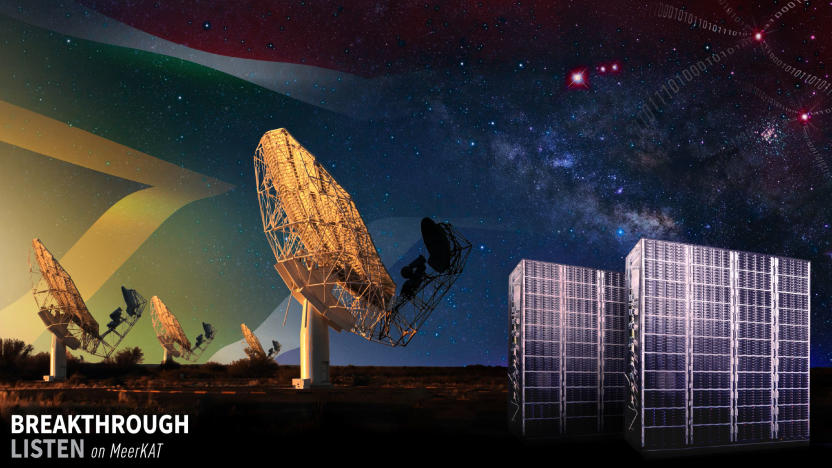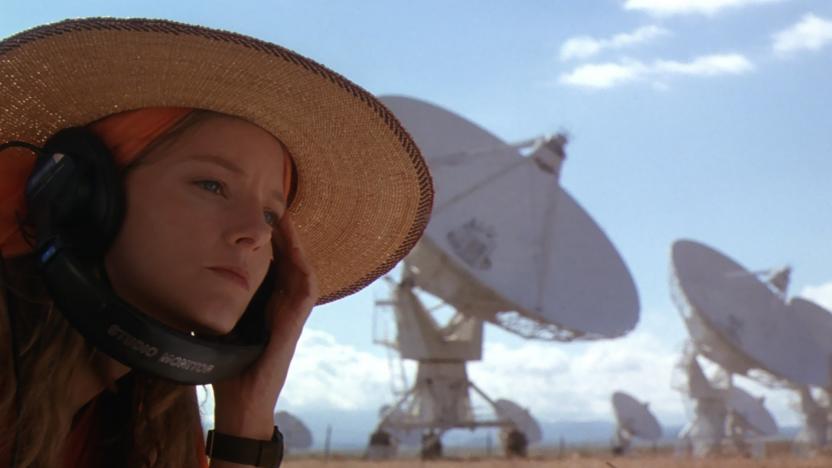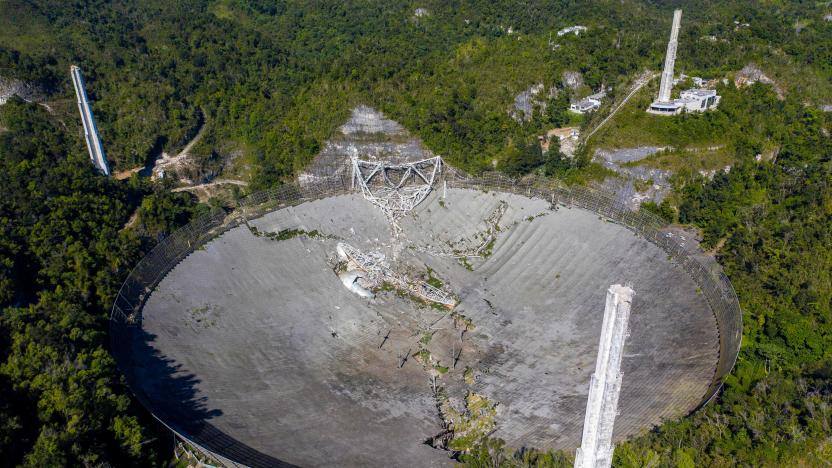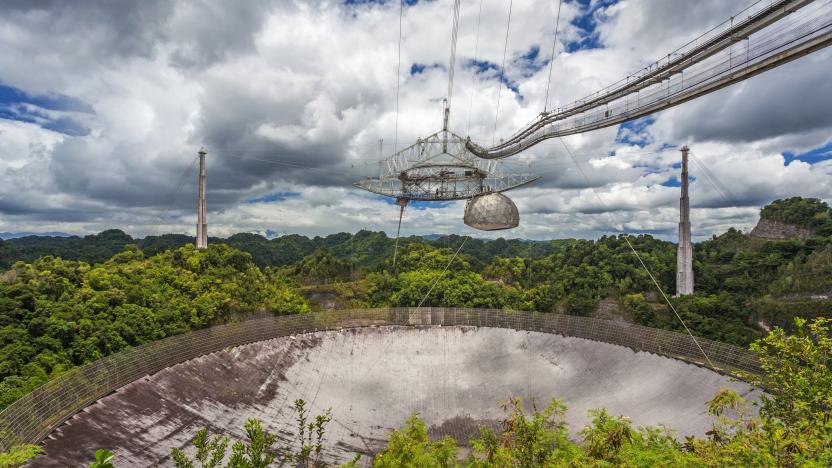radio telescope
Latest

Southern hemisphere’s largest radio telescope joins search for extraterrestrial tech
The Breakthrough Listen project will now be able to search more than a million stars within two years as it searches for signs of intelligent extraterrestrial life.

Hitting the Books: What exactly did Jodi Foster hear in 'Contact'?
As Naomi Pequette argues in her essay "The Sounds of Contact" as part of The Science if Sci-Fi Cinema collection, being "based on a true story" doesn't exactly mean we're getting the whole story.

China's huge FAST telescope will open to scientists globally in April
China will open its 500-meter (1,600 foot) "Sky Eye" FAST telescope to the global scientific community starting on April 1st.

Puerto Rico commits $8 million to rebuild Arecibo telescope
Puerto Rico has approved $8 million to help rebuild the Arecibo Observatory telescope, although it will likely need considerably more help.

Recent damage to the Arecibo telescope could keep it offline for months
It could take months to repair Arecibo Observatory, the second-largest radio telescope in the world.

Puerto Rico’s Arecibo radio telescope suffers serious damage
A broken cable damaged the Arecibo Observatory, the second-largest radio telescope in the world.

China's giant radio telescope will start searching for aliens in September
China's FAST radio telescope will join the search for signs of extraterrestrial life in September.

Arecibo Observatory nets $19 million grant to search for dangerous asteroids
NASA has ensured the Arecibo Observatory in Puerto Rico can continue its search for near Earth objects (NEOs) that pose a threat to the planet with a $19 million grant. The fund was awarded to the University of Central Florida, which operates the observatory on behalf of the National Science Foundation.

Radio telescope array could unlock the secrets of the early universe
To capture the night sky and better understand the formative years of our universe, astronomers are using something a tad more powerful than a traditional telescope. The Owens Valley Long Wavelength Array (OV-LWA) leverages 250 radio antennas, spread over a desert area equivalent to 450 football fields, to detect slender radio signals produced by distant pulsars, solar flares and auroras. Together, this army of antennas can capture the entire sky simultaneously and feed the resulting data back to the Owens Valley Radio Observatory. With over 25 terabytes flowing in every day, astronomers can study space weather, such as auroras, which occur when stars release magnetic energy.

Australia Square Kilometre Array Pathfinder goes live as the world's quickest radio telescope
Australia's Shire of Murchison is quickly becoming a hotbed for radio telescopes. As of of Friday, the territory is operating the world's fastest radio telescope in the form of the Australia Square Kilometre Array Pathfinder (ASKAP). The 36-antenna grid's eventual use of six phased array feeds, each with 188 receivers, will let it scan a field of view 150 times larger than the moon's visible area while processing that information much faster than a typical single-pixel radio telescope feed -- CSIRO estimates that an image of the Centaurus A galaxy that would take 10,000 hours to process with rivals should take five minutes with ASKAP. Ultimately, the array should grow to 60 antennas as part of the Square Kilometer Array, which includes South Africa in its hunt for pulsars, quasars and other unique parts of the universe. Just don't get your hopes up for booking alien listening sessions anytime soon. Commissioning started virtually as soon as the ribbon was cut, and scientists have already scheduled their usage slots for the next five years. We're sure we'll get over any frustration when we see the first ASKAP results published within the next year.

Radio astronomy pioneer Sir Bernard Lovell dies at 98
Astronomy just lost one of its vanguards, as Sir Bernard Lovell has died at 98. The UK-born scientist was best known as a cornerstone of radio telescope development. While he wasn't the first to leap into the field, he established the University of Manchester's Jodrell Bank Observatory to study cosmic rays in 1945 and organized the construction of what would ultimately be called the Lovell Telescope -- a radio telescope so large and useful that it's still the third-largest steerable example in the world, 55 years after it was first put into action. His work helped track some of the earliest spacecraft and was instrumental in confirming the first discovered pulsars and quasars. On top of his most conspicuous achievements, Sir Lovell played an important role in developing airborne radar during World War II and was lauded for having scientific curiosity long after he hung up his Jodrell director's hat in 1980. Science will be poorer without him. [Image credit: NASA; thanks, Darren]

IBM cluster powers Murchison Widefield Array's radio telescope, answers mysteries of the universe faster than ever (video)
Radio telescope operators have as much of a problem coping with the avalanche of data as getting that information in the first place. The Victoria University of Wellington is all too aware and is leaning on IBM for a powerful (if very tongue-tying) iDataPlex dx360 M3 compute cluster to sift through the deluge at the upcoming Murchison Widefield Array. Combined, the 4,096 array antennas probing deep space and solar atmospherics will have the Xeon-based cluster tackling signal data to the tune of 8GB per second, and about 50TB per day -- that's a Nexus 7's worth of astronomy faster than you can sneeze, folks. A 10Gbps network connection will feed the results to Perth to save scientists a roughly 435-mile trek. Construction is still in mid-stride, but the $51 million Australian ($52.2 million US) being spent on the Murchison array may be worthwhile if it helps solve the riddles of star formation and solar flares.

IBM: 'We must build an Exascale computer before 2024' (video)
ASTRON has enlisted the help of IBM to lead a five-year, $43 million project to develop and build a supercomputer for the new Square Kilometer Array. The SKA is a $2.1 billion initiative to construct the world's largest radio telescope across a 3,000km strip of Australia or South Africa. It's hoped to be around 50 times as powerful as the dishes we currently point heavenward and will be used to examine the deepest reaches of space to learn more about the formation of the universe. When it goes live in 2024, it'll produce an Exabyte of data each day: twice as much information as there is traffic on the internet in the same period. Of course, no existing computer could handle the job, so Big Blue has a slim 12 years in which to turn nascent technologies like Nanophotonics, 3D chip stacking and phase change memory amongst others into a practical, workable Exascale computer. Its either that, or somehow daisy-chain 100 million PCs with enough power and cooling fans to keep it all working and hope for the best. If you'd like to know more, then head on past the break, although unfortunately it won't count as college credit.

Russia's RadioAstron telescope finally set to launch, blanket space with its radio eye
Considering all the space nostalgia we've been swimming in recently, it's somewhat appropriate that a Cold War-era telescope is gearing up to make its maiden voyage, after more than three decades of development (and delays). The Russian mission, known as RadioAstron, will finally become a reality on Monday, when a radio telescope launches from Kazakhstan's Baikonur cosmodrome before soaring into orbit some 350,000 kilometers away from the Earth. At just ten meters in width, the craft's antenna is small in comparison to other radio 'scopes, but its reach can be dramatically expanded when combined with signals from those on the ground. This technique, called interferometry, will effectively create the largest telescope ever built, covering an area nearly 30 times the Earth's diameter and allowing RadioAstron to capture interstellar images in 10,000 times the resolution of the Hubble Space Telescope. There remains, however, one major hurdle -- because the spacecraft collects data at about 144 megabits per second, it must constantly transfer information to antennas on the ground. Problem is, there's only one antenna capable of receiving RadioAstron's signals and, unless others are constructed soon, a healthy chunk of its observations could be lost. How do you say "buzz-kill" in Russian?

SKA radio telescope to pump out more data than the internet in 2020, spot ALF before he lands
Unfortunately for Desmond Dekker fans, this SKA telescope has nothing to do with the Jamaican music sensation. No, the Square Kilometer Array (SKA) radio telescope has much more otherworldly concerns, and according to the director of the International Centre for Radio Astronomy Research (ICRAR), Peter Quinn, it should have the internet beat in terms of data when it goes online in 2020. The telescope, which will end up in either Australia, New Zealand, or South Africa, is aimed at searching for Earth-like planets, extraterrestrial life, dark matter, and black holes, and will require a central supercomputer with "the processing power of one billion PCs." What's more, it is expected to be 10,000 times more powerful than any telescope in existence and "generate the same amount of data in a day as the entire planet does in a year." We say anything that gets us closer to having our very own hairy, Hawaiian-shirt sporting alien on hand is well worth the $2.1 billion it will cost to create. Willy!

Astronomers snap black hole murder in graphic detail (video)
We tend to imagine a black hole sucking everything around it straight into oblivion. The truth, however, is even more gruesome. Astronomers have just captured an ultra hi-res image of our neighbouring galaxy, Centaurus A, and it helps to reveal what actually happens. Matter is yanked helplessly towards a black hole at the galaxy's core, but it refuses to die quietly. For some unknown reason, it erupts as it falls, spewing out vast plumes of particles -- like blood from celestial murder. These death throes emit radio waves, allowing us to witness them using radio telescopes even though we are 12 million light-years away. If only we were closer; if only we could intervene. Alas, all we can do is watch the video after the break and hit the source links for a fuller explanation -- though, admittedly, none of those sound like awful options.

Save Arecibo: because aliens don't do voicemail
The folks at SETI@home have put out a desperate plea for the community to bust out those quill pens and start writing strongly-worded letters to congress persons. Apparently the Arecibo Observatory, the world's largest radio telescope and SETI@home's data source, is being threatened with some massive budget cuts. Given that a replacement for Arecibo won't be online until 2020 at best, folks are understandably upset. Turns out Arecibo is also one of the best shots we have at detecting an earth-threatening asteroid before it's too late and we have to sit through another Elijah Wood movie on the subject. You know what you have to do.[Thanks, Brian]











